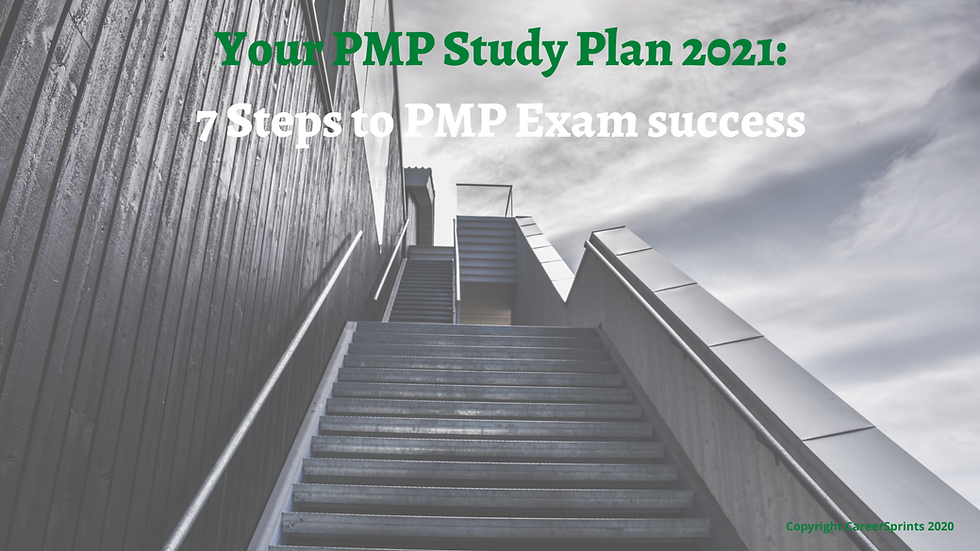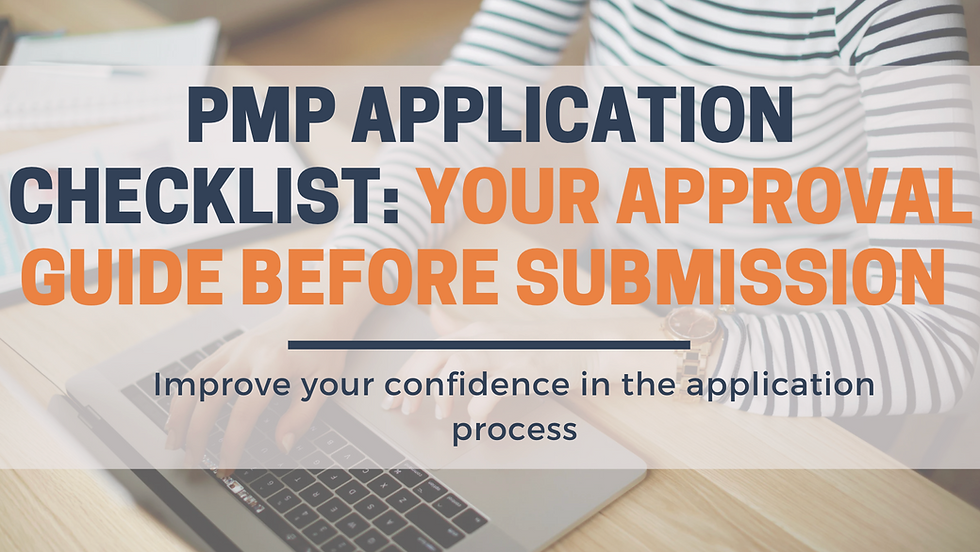Your PMP Study Plan 2021 & 2022: 7 steps to PMP exam success
- Rohit Gupta

- Jun 26, 2021
- 7 min read
Updated: Jul 30, 2025

If you've already done your research about the PMP exam, by now, you must have realized that it's a mammoth of a goal to accomplish. The Project Management Professional (popularly known as PMP) is considered a gold standard in the project management community and serves as a badge of honor for those who've demonstrated the commitment, discipline, focus, and hard work in acquiring the coveted designation.
That being said, there are now over a million people who have their PMP, and so can you. All you need to do is have a plan of how you will get there and follow it.
Whether you're new to the field of project management or someone with years of project management experience, having a study plan for the PMP will always prove to be helpful in your journey to acquire the PMP. Planning becomes even more critical when you're trying to study for the PMP along with work commitments. Think of PMP exam preparation as an exercise in managing a project of your own and testing your skills.
Here are 7 steps to follow to get that coveted PMP designation under your belt.
Step #1: Understand roughly how much time and effort is needed for PMP exam preparation.
The first step in accomplishing any task or initiative is to assess what it entails. For the PMP exam, this means understanding what material is covered on the exam and the exam format. Knowing the breadth of the material tested in the exam will enable you to plan more realistically. However, on average, the PMP exam preparation timelines range from 2-3 months or roughly 80-100 hours of study and practice. To find out how many months you'll need to compare the total time you can spare during a week to the total time required for preparation. Remember to keep the plan high-level and keep room for flexibility in your schedule. There could always be certain days when you might not have the time to study due to professional and personal commitments.
Step #2: Plan your exam end date and exam preparation approach
After acquiring an understanding of the materials and the exam structure, get an idea of when you would like to take the exam and your exam preparation approach. This does not mean booking the exam but merely planning a particular week or month by when you would want to write the exam. When it comes to approaching the exam content, there are different ways you can do this. For example, some people like to learn in a classroom setting, so they take physical or virtual PMP classes. Others who have a busy work schedule might not have the capacity to spare five days straight in a class and prefer a self-paced course option. Whatever option you choose, remember that the selected option must work with your learning style, costs, and schedule. For example, we've had several busy professionals leverage their PMP exam preparation with our PMP e-learning courses and attained success.
Step #3: Go through the exam preparation materials and the PMBOK patiently.
While studying for the PMP exam, patience is key. The concepts in the PMBOK and the supporting materials are quite comprehensive, and you must go through them with focus and concentration. For example, the first time you read the PMBOK, you might feel overwhelmed with the way it's structured. Hence, breaking down the exam content and tackling one chapter at a time from the PMBOK is a better approach. For example, you can read one chapter from the PMBOK and supplement it with watching the videos in your PMP e-learning course and solving end-of-chapter questions.
Step #4: Prepare for agile along with predictive project management.
Until the end of 2020, the exam PMP content was primarily predictive. Beginning in 2021, the PMP exam content contains both predictive and agile concepts. So, if you've worked in a waterfall-style environment for most of your career, agile might seem like a newer topic for
you. However, with the release of PMBOK 6th edition, PMI also released the PMI Agile practice guide, a 210 pages book that covers various agile topics written in collaboration with the Agile alliance. So, reading the PMI Agile Practice guide in addition to the PMBOK is vitally important since nearly 50% of the PMP exam is now agile. Furthermore, grab a free copy of the scrum guide and read it thoroughly, too, since scrum is a widely used agile framework and a majority of the agile questions in the PMP exam are on scrum.
Step #5: Practice enough mock exams and questions
The PMP exam is truly a test of your ability to comprehend the question and relate it to a project management concept. Plus, the exam length is 4 hours, and the majority of the questions are situational. Further, several questions in the exam can be pretty lengthy and will require good reading speed and comprehension abilities. As the saying goes, 'Practice makes perfect', so getting ample practice before the exam is paramount. Most of us writing the PMP are not in the habit of sitting for long hours writing an exam anymore, so it's essential to put yourself through that situation as much as possible to become comfortable with it.
Additionally, practicing various mock questions from different sources can give different perspectives of the exam. One important thing to note is that whatever resource you choose, make sure they provide a good mix of predictive and agile-based questions. You must solve at least 4-5 mock exams with an average score of 75-80% to feel confident about sitting the actual exam.
Step #6: Review wrong answers from chapter tests and mock tests
Knowing the material and solving mock papers isn't enough if you aren't learning from your mistakes. Even with high scores in the mock tests, you must review all your incorrect answers. This will ensure you don't miss out on concepts you must know for the exam and eventually add to your score in the actual exam. While reviewing incorrect answers, it's a good practice to refer to the sections of the PMBOK provided in the answer explanation. Doing this will help you identify the reason for the wrong choice and reinforce the correct answer. Follow this process for every chapter or mock test you solve.
Step #7: Read through the PMBOK one more time and solve more questions
The PMBOK is a massive book. It's nearly impossible for anyone just to read it once and be able to retain the information. With 10 knowledge areas and 49 processes, after a point, it can become quite difficult for anyone to remember the content within each of the processes or knowledge areas. Additionally, project management is an integrated discipline where various processes, tools, and techniques connect with each other. Hence, every time you read the PMBOK you'll discover these new connections amongst the multiple processes and knowledge areas which strengthens your understanding of the subject matter and aids you while answering questions, further improving your overall performance. Keep solving mock questions all along this step to check how much of your understanding has improved.
Some additional tips for PMP exam success
In addition to the steps given above, here are some additional tips to support you during your PMP exam preparation.
Review the glossary in the PMBOK and the Agile Practice Guide
Although overlooked by many PMP exam candidates during their exam prep, the glossary serves as an excellent resource to familiarise yourself with several definitions, terminologies, and acronyms used across the PMBOK. You can also convert the glossary into flashcards for on-the-go-byte-sized learning.
Get on board with a study group for additional motivation
Preparing for the PMP exam is an enormous task with weeks and months of commitment and dedicated effort. Therefore, it's common to lose your motivation along the way, especially when you're all alone in the journey. It's probably a good idea to join a study group locally or online. Not only you'll feel charged with the energy of other candidates, but you'll also be able to learn about other resources you can leverage for your PMP exam prep and learn from other people's experiences and mistakes.
Use flashcards
Using PMP flashcards is a great way to break up the PMP content in micro-sized learning artifacts. Flashcards can be Q&A-based, definitions, acronyms, or formulas related to the PMP exam. The beauty of using flashcards is that they are portable and can be used for quick learning whenever you find the time. These days you'll find both paper-based or app-based flashcards, or if you want to go a step further, create some of your own, especially for the content that you might find difficult to remember.
The PMP exam is difficult but not unattainable. Many candidates have found success in passing the PMP exam using a strategy such as the one written above.
However, it's also important to remember that everyone is different and that no one size fits all. Feel free to take cues from various sources and design your custom PMP study plan. Lastly, remember that, no matter what process you follow, the key ingredients of dedication, hard work, and effort are what will pave the way for a successful PMP exam pass recipe.
Are you a busy professional? Do you need help with your PMP exam preparation? Then you might need a reliable e-learning PMP course to aid you with your PMP exam preparation. Look no further; get an obligation-free quote for our highly effective, comprehensive, and proven PMP e-learning course.
About the Author
Rohit Gupta is a PMP and PRINCE2 certified project management trainer with 15+ years of experience training a global audience of more than 50,000 candidates.
He has helped over 500 professionals get their PMP applications approved and mentored 300+ candidates to earn their PMP certifications. As a lead coach at CareerSprints, Rohit continues to guide project managers with personalized, real-world preparation strategies.
Rohit is recommended by many PMP exam candidates for his ability to guide them through the PMP application process and for his personalized, structured coaching style that helps them achieve certification success.
He also holds other prestigious and in-demand certifications such as ITIL expert, Scrum Master Certification, FCAS certification and DevOps Foundation Certification.




Comments